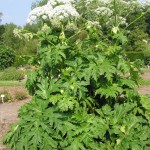Giant hogweed, (Heracleum mantegazzianum), is an invasive new weed that is colonizing in some parts of Ontario, eastern Provinces and Western Canada. Locally, it has been found in Ottawa, Halton region, Waterloo, Markham and the Don River valley in Toronto according to a report in The Globe and Mail. Giant hogweed is very dangerous. Its sap contains furanocoumarins and is toxic on contact, causing inflammation. Worse, the sap is phototoxic, which means it gets stronger when exposed to sunlight. When this happens the sap can cause severe and disfiguring blistering. If it gets in your eyes, it can cause temporary and even permanent blindness. It is important to note that giant hogweed is currently only being found in wild and overgrown areas like ravines, roadsides, riverbanks, vacant lots and would likely only pose a problem for homeowners with an unmowed lawn.
Giant hogweed lives up to its name, a mature plant growing to over fifteen feet in height. You can identify it by the large, serrated elephant-ear shaped leaves and a hairy, purplish-red stem. It is difficult to identify in it’s infancy and can be confused with several other weeds- do your homework. It also produces clusters of white flowers in an umbrella-like formation in June and July. It reproduces by seed each year.
If you find a giant hogweed, leave it alone, and contact a licenced professional weed exterminator like LawnSavers to remove it. Teach children what it looks like by keeping them informed, to keep away from the plant if they see it, and to tell you or another adult. If you get the sap on your body, immediately wash the area with soap and water and seek medical attention. Keep the exposed area out of the sun for several days.
If you have to remove the plant yourself, make sure you are completely covered in protective clothing, and wear impermeable gloves and eye wear. Put any seed heads in a separate and tied plastic bag and dispose of it in the garbage, not the green bin, so the seeds do not spread. Roots can be deep and should be cut 12 inches deep. If you are just finding juvenile shoots, mowing regularly will kill the shoots and eventually exhaust the supply of seeds in the soil. Just be extra careful and follow the noted safety procedures when disposing of the clippings. Since it is considered a noxious weed in most municipalities, a licensed weed exterminator like LawnSavers can use a chemical pesticide to kill the plant properly when it is young, down to it’s roots. You can also contact your local or regional conservation authority for additional information.
Please be prudent & careful. This plant is beginning to spread far too qucikly for our liking. It’s time for the government to step up and take responsibility and create an action plan to eradicate this imported and invasive species rather than pandering to anti-pesticide sentiment among some well meaning but misinformed activists.
For more information and pictures see: Ontario Weeds
Call LawnSavers Plant Heath Care at 1-888-503-LAWN(5296) or email us through our contact page
For general questions call TeleHealth Ontario at 1-866-797-0000 or TTY 1-866-797-0007







